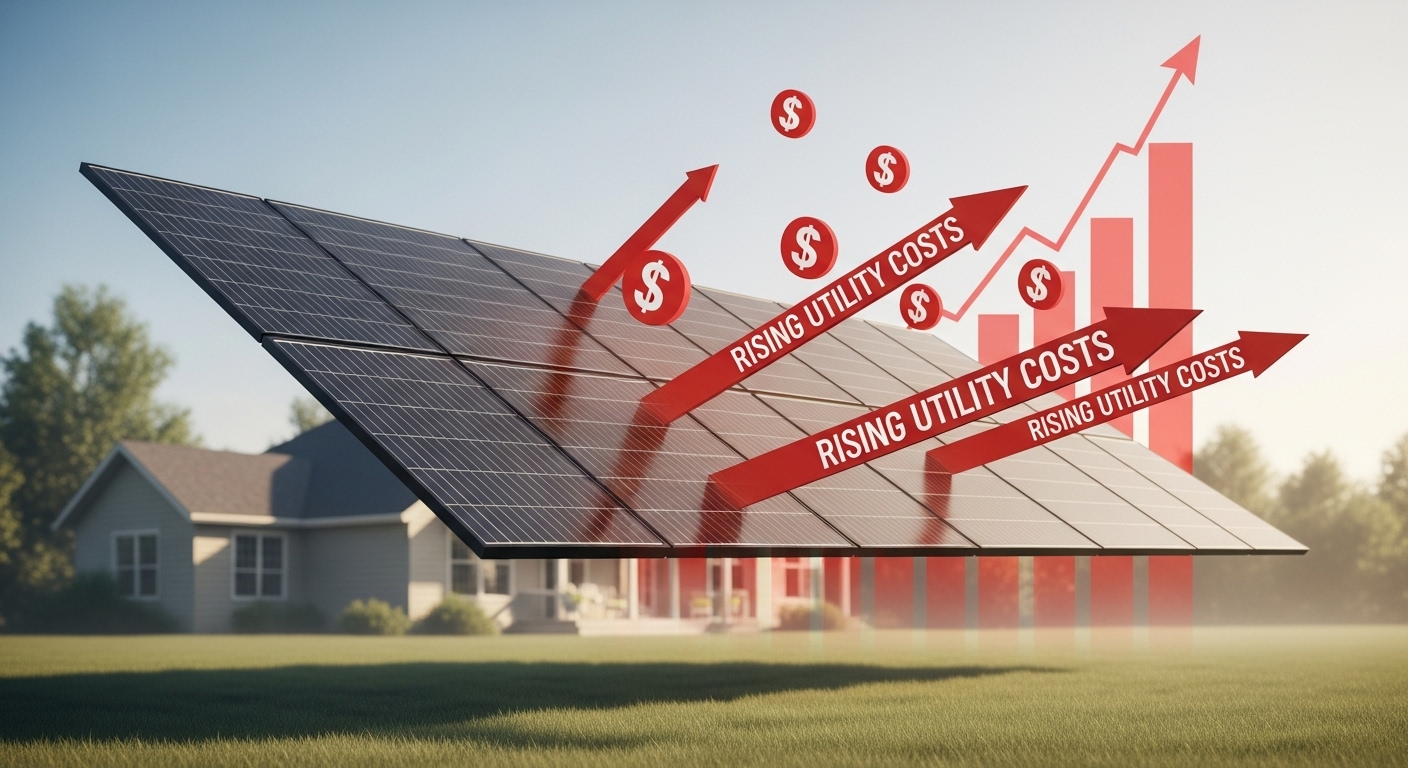Article
Are Electricity Prices Really Going Up? A Look at 10-Year Utility Rate Trends

It’s no secret that electricity prices have been rising, but how much, and why? To answer that, we need to examine the broader patterns behind utility rates. Let’s dig into the data, uncover what’s driving these price shifts, and see what they mean for the future of your electric bill.
Understanding Utility Rate Trends
Utility rates, measured in cents per kilowatt-hour (kWh), reflect shifts in the energy market and directly impact your electric bill, offering insight into the underlying dynamics of the energy market. For both homeowners and businesses, tracking utility rates offers important insights, especially when making decisions about energy efficiency upgrades, appliance purchases, or investments in renewable energy.
Historical electricity rates in the U.S. have generally risen in line with inflation, but this masks significant variations depending on the region and timeframe. According to a 2024 report by Energy Innovation Policy & Technology, electricity prices have increased by roughly 40% since 2010, closely tracking the broader Consumer Price Index. But in places like New England and California, rates have risen significantly faster than inflation, creating challenges for household budgets.
Historical Trends in Utility Rates
From 2013 to 2023, the Energy Information Administration saw residential electricity rates rise from just over 12 cents/kWh to about 16 cents/kWh—an increase of roughly 33% in nominal terms. When adjusted for inflation, the real increase is less than 1%, meaning average consumers are paying about the same in purchasing power terms. However, this national average masks significant regional disparities and year-to-year fluctuations.
For example, in 2022 alone, electricity rates surged by over 11% due to a spike in natural gas prices. Between 2019 and 2023, rates grew at an annual pace of nearly 5%. New England and California experienced above-average increases, with annual real growth in prices of over 2%. By contrast, states like Utah and Nebraska saw real declines in electricity costs over the same period.
Factors Influencing Electricity Price Changes
Several drivers explain why electricity rates have gone up:
- Fuel Costs: Natural gas is a major input for U.S. electricity. When its price spikes, like it did in 2022, utility bills follow suit.
- Infrastructure Investments: Utilities are spending billions to modernize their grids, meet safety standards, and integrate renewable energy sources, all of which are funded through rate increases.
- Environmental Regulations: Cleaner energy mandates often require upfront investments in new power plants or emissions controls.
- Supply and Demand: When demand increases (due to EV adoption, population growth, etc.) without sufficient new supply, prices rise. However, if energy efficiency reduces overall demand, utilities must still recover their fixed costs. When fewer kWh are sold, the price per unit often rises to cover these expenses.
Future Projections for Electricity Prices
While data on historical electricity rates helps us understand where electricity prices have been, it’s the future that’s raising eyebrows and energy bills. With major shifts underway in how we power our homes, cars, and digital infrastructure, experts are forecasting some steep increases in utility rates over the next decade. Whether supply can keep up, and how utilities, regulators, and consumers respond, will play a big role in determining what we all pay for power in the years ahead.
Forecasting Future Utility Rate Increases
The future of electricity pricing points toward continued increases. The consulting firm ICF projects residential electricity rates could rise between 15% and 40% by 2030, depending on how fast new demand (from electric vehicles, data centers, etc.) grows and whether utilities can keep up with infrastructure.
The White House Council of Economic Advisors has warned that electricity prices could be anywhere from 9% to 58% higher by 2030 due to the high energy needs of AI and cloud computing. That means bills could rise even faster than in the next decade unless energy supply, particularly clean energy, is rapidly expanded.
State-by-State Disparities in Utility Rates
Electricity is far from evenly priced across the U.S. Hawaii tops the charts with residential rates around $0.30–$0.40/kWh due to imported fuel. New England states, such as Connecticut and Massachusetts, hover around $0.25–$0.30/kWh, driven by fuel constraints and clean energy goals.
Meanwhile, states in the Mountain West and Midwest, such as Utah and North Dakota, enjoy rates as low as $0.09–$0.12/kWh, thanks to inexpensive local generation and low demand. However, high usage in hot Southern states can still result in large monthly bills, despite low rates.
The Role of Renewable Energy in Stabilizing Prices
As electricity prices continue to climb, many are asking whether there’s a way to bring costs under control, or at least make them more predictable.
How Renewable Energy Affects Utility Rates
Renewables like wind and solar have near-zero fuel costs and low operating expenses, which can help lower or stabilize electricity prices. In Texas, the growth of wind and solar from 2010 to 2022 saved an estimated $31.5 billion in wholesale electricity costs.
By displacing fossil-fueled power, renewables make energy prices less volatile. States with strong clean energy growth, such as Iowa, New Mexico, and Kansas, have seen electricity price growth well below the national average.
Solar Energy as a Financial Hedge
Rooftop solar empowers homeowners to generate their own electricity at a fixed cost, shielding them from utility rate hikes. A solar system can save tens of thousands of dollars over 20 to 25 years. For example, a homeowner paying $150/month on a solar loan may eliminate a $220 utility bill, netting $70 in savings each month.
With solar panel and battery prices going down and local incentives gaining popularity, solar has become more accessible than ever. Many households can go solar with zero down and start saving immediately. Over time, those savings only increase as grid prices rise.
Regulatory Factors Influencing Utility Rates
Behind every utility bill lies a complex web of regulations, incentives, and policy decisions that influence the amount you pay for electricity. These rules govern everything from how utilities recover their costs to the integration of clean energy into the grid. Understanding the role of regulation is essential to understanding why electricity prices rise and what might be done to keep them in check.
Understanding Government Policies and Regulations
State-level Public Utility Commissions regulate utility rates. Utilities must justify rate increases by showing that costs are necessary and prudent. This process ensures that utilities can’t arbitrarily raise prices; they need to demonstrate that higher rates are warranted (for example, due to increased expenses or needed grid upgrades).
Environmental and efficiency mandates also impact pricing by requiring investments in cleaner infrastructure. Federal tax incentives, such as the ITC and energy efficiency credits, also play a role, lowering customer costs and encouraging homeowners to invest in clean technologies.
Future Regulatory Trends and Their Implications
Looking ahead, regulatory changes could redefine how consumers are charged for electricity. Many utilities are pushing to restructure bills by raising fixed charges or implementing time-of-use pricing, where electricity costs more during peak demand hours. While these models can incentivize smarter consumption patterns, they can also complicate cost-saving strategies for homeowners.
At the same time, net metering policies are being reevaluated across the country. In states like California, reductions in compensation for solar exports (such as NEM 3.0) have reshaped the economics of rooftop solar. However, these changes don’t eliminate solar’s value; they just shift how homeowners maximize their return, often by incentivizing home batteries.
To stay ahead, homeowners should follow local utility proceedings, explore available incentives, and remain flexible in their energy strategies.
Mitigation Strategies for Rising Electricity Costs
While rising electricity rates may seem inevitable, that doesn’t mean you’re powerless to push back. In fact, there are more tools than ever for homeowners to take control of their energy costs and insulate themselves from future increases.
Energy Efficiency Improvements
Improving your home’s energy efficiency remains one of the simplest and most cost-effective defenses against rising electricity rates. Small changes, like upgrading to LED lighting, sealing air leaks, or installing smart thermostats, can significantly reduce household energy use and monthly utility bills. These savings accumulate year after year and often pay for themselves quickly.
For larger upgrades, such as high-efficiency HVAC systems, insulation, or windows, homeowners can often tap into generous tax credits and rebates. For example, the Energy Efficient Home Improvement Credit can cut the costs by 30%. Many utilities and state programs offer additional incentives, further improving your return on investment.
Efficiency isn’t just about saving money; it’s also about gaining control. When you use less electricity, you reduce your exposure to rate volatility.
Exploring Solar Investments
Investing in solar power is more than a way to reduce your monthly bill; it’s a long-term strategy to lock in energy savings for decades to come. With today’s financing options, solar has become accessible to a wide range of homeowners. In many cases, homeowners start saving money in the first month of going solar.
By generating your power, you hedge against future utility rate hikes and gain greater energy independence. Adding a home battery can enhance those benefits, allowing you to store excess power for nighttime use or during outages. In areas with time-of-use pricing, a battery can also help you avoid the most expensive hours of electricity.
Solar energy also enhances home value and makes your property more appealing to potential buyers. As more people prioritize clean energy and lower bills, solar-equipped homes stand out in the market. With federal incentives still available, but set to phase out by the end of the year, there’s never been a better time to explore your solar options.
Navigating the Changing Energy Landscape
The energy landscape is evolving rapidly, and rising electricity prices are only one part of a broader transformation. As the grid modernizes and adapts to new demands, including electric vehicles, data centers, and decarbonization, consumers must stay proactive.
Fortunately, tools and technologies exist to help homeowners take control. Whether it’s trimming energy waste, generating your own power, or shifting when you use electricity, there are more ways than ever to protect your household budget and reduce your reliance on the traditional grid.
Staying informed is key. Monitor local utility rate trends and changes, learn about new state or federal incentives, and take advantage of programs that reward efficiency and self-generation. Rising rates may be out of your control, but how much you pay doesn’t have to be.
By making smart energy decisions today, you can stay ahead of tomorrow’s price hikes and build a more resilient, affordable, and sustainable home energy future. Get started today with Solar Energy World. Since 2009, we’ve helped thousands of happy customers navigate the solar market and install custom solar systems. Reach out today to get started with a free solar estimate!
Want a Free Solar Estimate?
Fill out the form to get started today.


